
Understanding the Real Estate Strategies of Universities
In a challenging economic landscape, universities across the nation are grappling with financial shortfalls and declining student enrollments. Many institutions are reassessing their real estate assets, which have the potential to generate revenue and sustain operations during tough times.
The financial pressures from funding cuts, exacerbated by what experts are calling a "demographic cliff," are prompting colleges to make significant shifts in how they utilize their campuses. These strategies are not just about survival; they could reshape the educational landscape for years to come.
Financial Shortfalls: A Driving Force
The funding cuts currently affecting public higher education are part of a larger trend that has been unfolding for a number of years. With state funding dwindling, many universities find themselves in a precarious position. According to recent reports, some institutions have had to rely more heavily on tuition revenue, which is not sustainable, particularly as prospective students decline in number.
A growing concern is how these financial shortfalls will influence the local economy in areas such as San Antonio, where several educational institutions are pivotal economic players. Metrics show that a strong education system correlates with local business health, making it essential for universities to adapt their fiscal strategies.
Leveraging Real Estate for Sustainability
One solution gaining traction is leveraging real estate assets. Universities are starting to capitalize on properties they own, such as unused buildings and land, to generate income. This can take many forms, from leasing space to startups to opening facilities for community events.
For instance, in San Antonio, schools are exploring partnerships with local entrepreneurs, facilitating the growth of small businesses. This approach not only generates funds but also creates a vibrant ecosystem that benefits local economies and provides students with real-world business insights.
A Ballooning Challenge: The Demographic Cliff
The notion of a "demographic cliff"—a term used to describe the projected decline in the birthrate affecting traditional college enrollment—is causing schools to rethink their approach. As fewer high school graduates enter the pipeline, universities must not only preserve existing student numbers but find new avenues for attracting non-traditional students.
This environment forces institutions to innovate in areas such as marketing and student services while also integrating real estate strategies that connect with the broader community. For example, universities can host events or workshops in their spaces that appeal to adult learners, establishing themselves as community hubs.
Looking Ahead: What Changes Might We See?
Recent trends suggest that universities will continue to creatively adjust their real estate strategies as they seek to remain competitive. The future may see more universities transforming into multifunctional spaces that can cater to both academic and non-academic activities.
Moreover, financial pressures could further encourage partnerships with local businesses and industries, setting up unique programs and initiatives that bridge the gap between education and employment. This collaborative approach could open doors for innovation within academic institutions and support economic development efforts in the area.
Take Action: Support Local Education Initiatives
As universities strive to redefine themselves amidst these financial challenges, local communities must step in to support and advocate for educational initiatives. Engaging with institutions directly through community events, mentoring programs, and networking opportunities will enhance educational offerings and help foster a supportive environment for both students and local businesses.
By understanding and participating in these evolving dynamics, residents can play a crucial role in safeguarding the future of education and ensuring that local economies thrive amid change.
 Add Element
Add Element  Add Row
Add Row 



Write A Comment